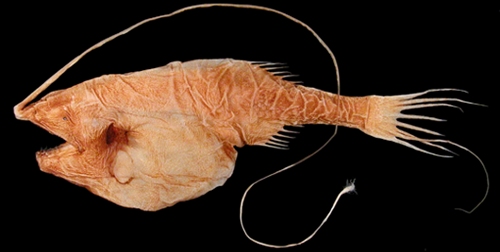

The gape is enormous and although the lower jaw is vertical when the mouth is closed, it can be moved downwards at more than a right angle. "They have large mouths and can eat quite large prey items." Günther, in his description of Melanocetus johnsonii, notes that "They are sharp and used to impale prey items," Sparks says. So in dark environments, the fish uses the glowing esca, which it can move to emulate prey, to attract its own prey, and-in a classic case of the hunter becoming the hunted-chomps down on whatever gets too close.ĥ. " just swimming slowly, as their body shape-globular-dictates," Sparks says. This is key in getting the anglerfish fed, because it isn't built for giving chase. The tip of the pole-looking thing protruding from the fish's head is called the esca, and its bioluminescence is produced by symbiotic bacteria. Photo courtesy the Biodiversity Library on Flickr.Ĥ. The largest male known is under 3 centimeters (1.18 inches), whereas the largest female is 18 centimeters (7.08 inches)."Ī sketch of the Humpback Anglerfish from the 1896 book Oceanic ichthyology : a treatise on the deep-sea and pelagic fishes of the world, based chiefly upon the collections made by the steamers "Blake," "Albatross," and "Fishhawk" in the northwestern Atlantic. Typically, Sparks says, this species is "3 to 3 1/2 inches. The females are much bigger than the males.

"In the family this species belongs to, only loosely attached, non-parasitic, males have been found on females-they still retain their teeth, etc."ģ. "That has not been found-yet-in this species," Sparks says. Still, that's not the norm for those fish-scientists have so far only found parasitic males in 5 of 11 ceratioid families, according to Sparks-and it's probably not what happens when humpback anglerfish mate, either. Those fish "are members of the suborder Ceratioidei, deep sea anglerfishes, in which some species are known to reproduce by that means," Sparks says. You may have heard how some anglerfish reproduce via the males fusing their bodies to the females' until they essentially become one the male loses his eyes, fins, teeth, and some internal organs and, from that point forward, lives off of the female, providing sperm when she's ready to spawn. He had obtained it from English naturalist James Yates Johnson, who had gotten the fish from Madeira -hence its scientific name, Melanocetus johnsonii.Ģ. The fish was first described by Albert Günther, keeper of zoology at the British Museum in London, in 1864. This one is a female, "probably the Humpback Anglerfish," Sparks says. Because the creatures live at such great depths, they're rarely seen alive-and, because of that, we don't know a whole lot about them. We asked John Sparks, a curator in the American Museum of Natural History's Department of Ichthyology, to tell us a few things scientists do know about this weird fish.ġ. There are six species in the Melanocetidae, or Black Seadevil, family. The video, shot at 1900 feet below the surface by a remotely operated vehicle, is believed to be the first footage of a live Seadevil in its natural habitat.

By now, you've probably seen the awesome footage of a Black Seadevil anglerfish captured by scientists with the Monterey Bay Aquarium Research Institute (if not, you can watch it above).


 0 kommentar(er)
0 kommentar(er)
